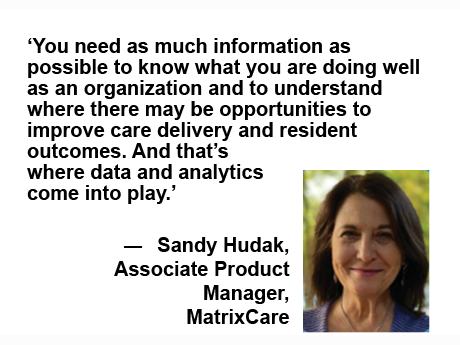State-of-the-art software tools can improve operational efficiency, enhance resident outcomes and boost the bottom line.
What can you utilize that has a positive impact on both residents and business results? Data and analytics. With real-time information on performance, senior care executives and clinicians can identify and overcome roadblocks to success.
New improvements in the use of data and analytics are helping to guide decision-making. Data mining can boost staff efficiency and profitability. At the same time, data entry is becoming faster and easier. Software tools with the latest graphics make trends easy to spot. Standardized metrics facilitate analytics across multiple properties.
“You cannot know how well you are doing as a company without information,” says Sandy Hudak, associate product manager at MatrixCare, a provider of post-acute electronic health records (EHR) software for the entire care continuum. “You need as much information as possible to know what you are doing well as an organization and to understand where there may be opportunities to improve care delivery and resident outcomes. And that’s where data and analytics come into play.”
Sponsored: Learn more about MatrixCare Solutions. Schedule a customized demo.
Three executives at MatrixCare recently discussed how the use of data and analytics can be leveraged to improve operations, outcomes and profitability.
Here are their top five suggestions:
1. Harness data. “Are you actually recording what you are doing?” asks Hudak. “We need to ensure we are documenting the care we are providing as clinicians to understand if we are delivering quality care as an organization.” Robust data lets clinicians fine-tune workflows to improve the team’s efficiency and make sure residents who need the most care at a given time get the most attention.
Having access to documentation can shed light on patterns of care delivery and help uncover potential gaps that might not otherwise be identified. Are we in compliance with regulations? Are we tracking key performance indicators from across various financial, operational and clinical modules? Data is needed to uncover pain points, areas of improvement and opportunities. “Data gives you the big picture,” says Hudak.

Bhakti Modi,
MatrixCare
Don’t be afraid of data, advises Bhakti Modi, associate product manager at MatrixCare. While the senior care sector has been slow to embrace data, the industry is moving forward. “Data can drive decisions in a more positive direction,” she says, adding, “Data is fun.”
2. Improve resident outcomes with real-time information. Data and analytics allow staff to be proactive and prevent poor outcomes by reviewing resident trends. “Reports can be pulled up in seconds,” says Tricia Jervis, business analyst at MatrixCare. She explains that the staff is not looking at one chart at a time and trying to remember if the person had suffered a fall. For example, Stonehill Communities in Dubuque, Iowa, implemented MatrixCare’s Clinical Advanced Insights platform to proactively focus on at-risk residents. A dashboard tells the staff if there are significant changes in diet, eating, mobility, activities and other metrics. The care team and families can be quickly informed about changes and care plans can be adjusted.

Tricia Jervis, MatrixCare
Corporate executives can easily see results across the portfolio. Managers don’t need to pick up the phone to call each facility or send an email blast to collect certain metrics, such as infection rates. “Everyone is looking at the same data points,” says Jervis. She adds, “It’s a game changer for meetings.” No one has to take the time out of a busy day to assemble the data to be discussed at the meeting. The data is generated instantly and is easy to pull.
3. Increase staff efficiency. The EHR should not be the focal point of a caregiver’s or clinician’s day. Reporting should be fast and intuitive, and the software should be easy to use, especially in today’s hectic healthcare environment. “The MatrixCare platform provides access to the information caregivers need,” says Hudak.
Staff members can be grouped by job function so that logging in takes them directly to the page where they need to be, says Jervis. The staff can designate “favorites” to readily access the pages they visit most often. “They are not navigating aimlessly.”
Also, the platform’s analytics have predictive as well as retrospective capabilities. For example, a nurse from a staffing agency who may not know the residents well can pull up a list of those with higher acuity who might need more help or who aren’t eating well. Another plus: executives can use analytics to make good decisions on where more staffing might be needed based on specific resident needs. “When you see those analytics up front you can staff appropriately,” says Jervis.
Another consideration is that tech-savvy young workers expect to have software tools to help them do their jobs. They’ve grown up using smartphones and other devices. Paper-based data entry is a thing of the past.
4. Spot broader trends. Collecting raw data is not enough. Analytics identify industry-wide trends and how an organization compares to those trends.
“We focus on the industry and the future needs of the client,” says Modi. MatrixCare’s EHR platform provides a big-picture view of operations. Sequoia Living, for example, manages 10 buildings. The executives needed a way to easily gather key information such as census and accounts receivable to track trends, spot potential issues and take action quickly. The company turned to the MatrixCare MyAnalytics platform.
Chief officers can generate reports to show the source of receivables without having to run multiple financial statements. The platform also offers census trends broken down by location and by level of care month-over-month or day-over-day, which aids in staffing decisions. This capability is crucial given today’s staffing shortages.
5. Track financials, manage reimbursements. Financial reporting may not get the same attention as infection rates, but tracking both can be critical to operations. Decision-makers can use data and analytics to track key performance indicators to optimize billing and cash flow. This information is critical for planning, forecasting and evaluating performance over time. The use of data and analytics can also find gaps in the reimbursement process. “Understanding reimbursement makes a big impact on the care that the facility is able to provide,” says Modi. The MatrixCare platform can chart financial metrics and track variances from month to month. Executives can understand which payors are reimbursing the company on time. Perhaps the number of residents has increased but the daily rate has decreased — resulting in poorer financial performance.
Is there enough staff to care for high-acuity residents who are reimbursed at a higher rate than other residents? What are we missing that is causing us to have less revenue? Analytics can answer these questions. Modi adds that the MyAnalytics tool offers advanced reporting so providers can create their own information dashboards for specific groups of stakeholders.
These five tips show how data and analytics can provide the insights needed to achieve better performance clinically, operationally and financially. Most importantly, data and analytics support strategic decision-making based on information, instead of hunches. The end result? Satisfied residents and families, an efficient workforce and a better bottom line.
— By Jane Adler. This sponsored content was written in conjunction with MatrixCare, a content partner of Seniors Housing Business.
Learn more about MatrixCare Solutions. Schedule a customized demo.

